7+ SAMPLE Cleaning Estimate
-
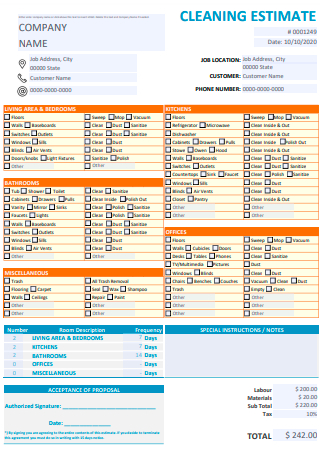
Cleaning Estimate Template
download now -
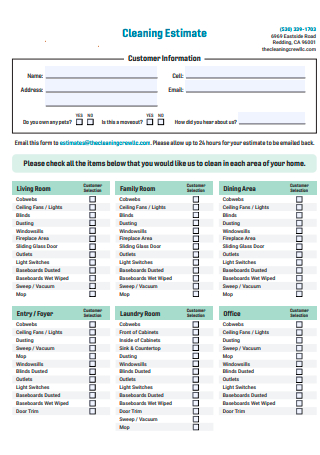
Basic Cleaning Estimate
download now -
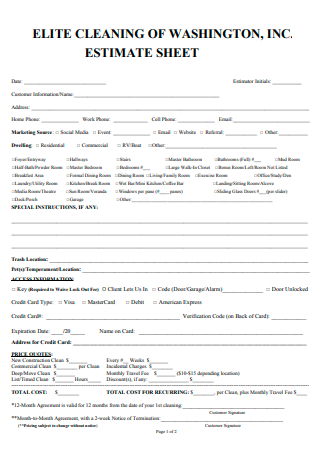
Cleaning Estimate Sheet
download now -

Cleaning Estimate Example
download now -
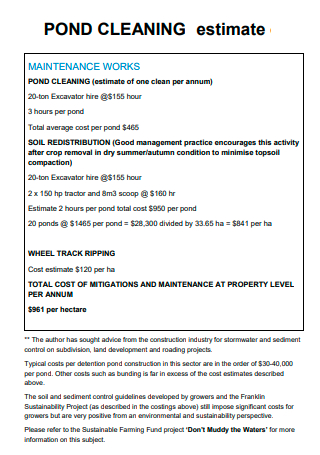
Pond Cleaning Estimate
download now -
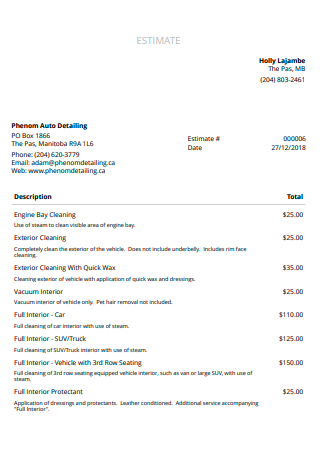
Printable Cleaning Estimate
download now -
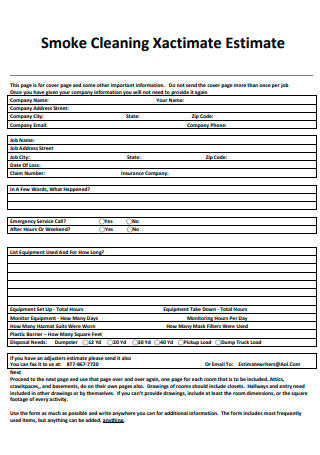
Smoke Cleaning Estimate
download now -
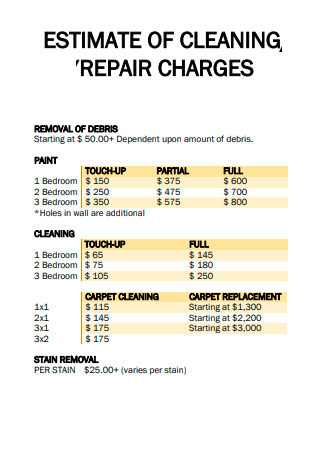
Cleaning Repair Charges Estimate
download now
FREE Cleaning Estimate s to Download
7+ SAMPLE Cleaning Estimate
What Is a Cleaning Estimate?
Types of Cleaning Estimates
Tips to Efficiently Clean a House
How to Make a Cleaning Estimate
FAQs
How to estimate cleaning an office building?
What are the differences between regular cleaning from deep cleaning?
How much should a housekeeper get paid hourly?
What Is a Cleaning Estimate?
A Cleaning estimate is a document used to determine the price and charge of the services the property owner will be paying you. Establishing the distinct costs ahead of time can provide you with the finest grasp of what you will have to include to generate the suitable pricing ranges for your company. It may take a few rounds for a new cleaning company to become acquainted with the cleaning service estimate procedure. That being said, it’s critical to understand how to use it correctly in order to make a reasonable living salary. Check out the cleaning estimate template provided so you won’t have to start from scratch.
Types of Cleaning Estimates
Before you can arrange your first cleaning, you must first understand how to provide a cleaning estimate. You should only be ready to provide estimates if you know what your Hourly rate will be, such as how much you will charge per hour, and you must also prepare a price sheet or cost calculator. You can provide your customer with one of three sorts of estimations. Finally, the estimation approach that generates the most consumers should be the one you consider implementing. This curated list will define the various types of cleaning estimate processes you can employ.
Tips to Efficiently Clean a House
Regardless if you work independently or with a team, cleaning a house will tire you out, especially if you will have to cover a large plot of land with various rooms within it. These are some tips that you can make use of to maximize your time and effort as much as possible. Although it isn’t necessary, as others have different and unique methods they prefer to follow through, you can take note of some of these tips if you see them. This isn’t a checklist but it can help you out all the same.
How to Make a Cleaning Estimate
Preparing for a cleaning estimate will not be easy, especially if you are new to the process and have little to no experience in making one. Not to worry though because this article will help you out through the process and even provide you with cleaning estimates samples so you can have a structured reference. Writing a cleaning estimate entails much more than just calculating the total cost of the job. It is beneficial to establish expectations and knowledge of all aspects of a task so that when the work is completed, both parties are happy.
-
1. Customer Information
It may surprise you to hear that incorporating client information in a cleaning estimate might help you get the contract. This indicates to the consumer that the cleaning estimate you generated is unique to their job and not a generic form that you provide to everyone. Customers appreciate the fact that you took the time and consideration to organize ahead of time. This goes without saying that you will have to ensure the accuracy of the information you placed in this section. Avoid typos in their names, addresses, and Phone and Email Contact Details.
-
2. Business Contact Details
A consumer must be able to readily find out how to contact you, particularly if they want to employ you for the task. Include your contact information at the top of your estimate so the consumer may readily contact you if they have any more questions. Never submit an estimate without clearly displaying your contact information on the estimate or including a business card.
-
3. Project Plan with Description
It is critical to clearly explain the work that must be done and to categorize the project’s expenditures into line items. You may believe that providing a description of the cleaning project is unnecessary if you have previously discussed it with the customer; nonetheless, including it in the estimate proves that you and the customer have fully spoken about the project’s expectations. If the customer reads the description and notices something that isn’t what they expected, it’s simple to fix before the Task begins. This section will help clients to understand why the estimate produced a specific amount.
-
4. Payment Schedule Specifications
Set your payment requirements in advance. If it is a one-time cleaning operation, such as post-construction cleaning or move-out cleaning, specify when and how payment will be made and inform the customer. If it is a regular task, such as housework, establish an agreed-upon payment plan. Having a clear grasp of payment deadlines can benefit both parties after completion and guarantee that you get compensated for a job well done. You should also specify what method of payment is preferable. For the one-time cleaning, cash could be the main option whereas a continuous service could be done through card or online payment.
-
5. Insurance and Licenses
Cleaning professionals are not required to be licensed by trade, although business Licenses are sometimes required depending on your state or city protocols. Furthermore, obtaining insurance is critical if something is destroyed on the job. A work guarantee is a component of your estimate that will set you apart from the competition. As part of your business plan, this should be created prior to the estimate. By incorporating a guarantee, you are ensuring the customer that the job will be completed to the best of your ability and to the specified standards.
-
6. Permits and Special Requests
Some cleaning operations, such as post-construction clean-up, may need permits or close attention to detail in terms of removal of materials. Line items for dumpsters, containers or rental equipment should be included. Include any permissions that may be required for the project as well, as the buyer may not be aware of this. If the customer has made a special request, such as ecologically friendly cleansers or supplies, mention the cost of them as well if you are able to fulfill them. Specify all that has been discussed to ensure it is part of the agreement between you and the client.
FAQs
How to estimate cleaning an office building?
According to Long, rival providers will present clients with their pricing. However, keep in mind that, like any other cleaning service, office cleaners charge not only by the task but also by the square footage that must be cleaned. The average cost of commercial cleaning in 2019-2020 is $0.11 per square foot, with typical commercial cleaning prices ranging from $0.07-$0.15 per square foot. Cleaning workplaces up to 40,000 square feet will cost you between $04 and $. 10 cents per square foot. Keep that in mind as you draft an office cleaning estimate.
What are the differences between regular cleaning from deep cleaning?
When you engage a House Cleaning service for regular cleaning, you generally get your normal weekly cleaning responsibilities done. The primary goal of frequent cleaning is to maintain a specific degree of cleanliness in your home. Frequent cleanings are less costly than deep cleanings, despite them being recurring. While frequent cleaning is important for maintaining your cleanliness, thorough cleaning is far more extensive than your normal weekly clean. Deep cleaning includes thorough scrubbing as well as paying special attention to the frequently overlooked and difficult-to-reach areas. Deep cleaning is always more costly so you have to remember that when drafting a deep cleaning house estimate.
How much should a housekeeper get paid hourly?
A housekeeper should be compensated at the very least the minimum salary. The following is a list of the 2018 minimum salaries by state. The nationally regulated minimum hourly pay is $7.25. Housekeeper cleaners earn an hourly wage of $11.84 on average, with a low of $8.52 and a high of $16.87. The rate is also affected by the industry. Housekeepers who work in residences earn an average of $11.24 per hour. According to Indeed, hotel housekeepers earn an average of $10.68 per hour. California employs the most housekeepers, with an hourly wage of $13.88.
Coming up with a cleaning service cost estimate would be tricky if you are unsure of how to price your worth, but the important thing to keep in mind is that the price you set is how you value your efforts. Since you might have your hands already full with potential clients, then you should use the cleaning company estimate template to save you time and allow you to focus on other important things for your business.
